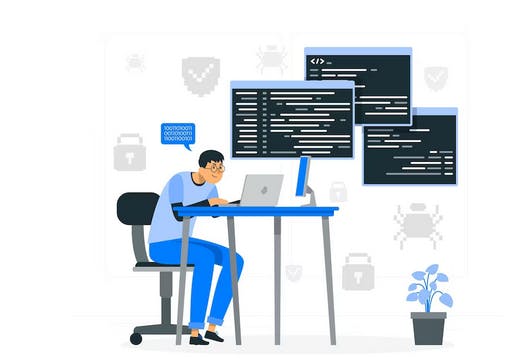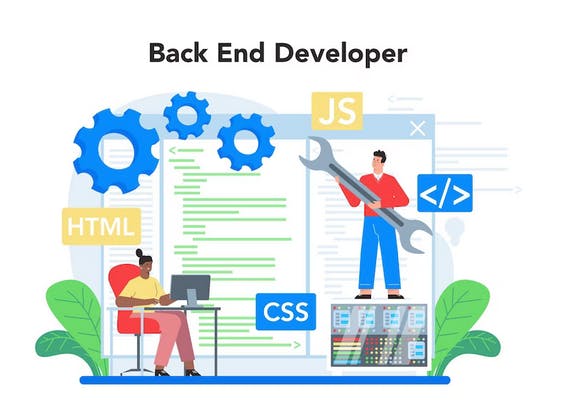
Photo by Fotis Fotopoulos on Unsplash
A step by step guide to web development for Beginners
Explore the Fundamentals of Web Development with HTML, CSS, and JavaScript
Introduction
In this article, we will explore the world of web development, beginning with an overview of the internet and its significance in our lives. We'll examine how web development has revolutionized communication, education, and online communities. The focus will then shift to the frontend development roadmap, which includes HTML, CSS, and JavaScript, as well as the importance of version control and responsive design.
Lastly, we'll discuss the use of CSS frameworks and JavaScript frameworks to enhance development efficiency. By the end, you'll have a comprehensive understanding of web development and the steps to embark on this exciting journey.
What is the Internet?
To understand what web development is, let us briefly refresh our memory about what the internet is.
The internet can be described as a powerful tool used by millions across the globe, yes you are using it to read this article right now. It works by connecting millions of computers, servers, websites, and pages. We can use it to send messages, emails, and videos to loved ones. It also serves as a tool for communication via social media and also a means of entertainment.

What is Web Development?
Web Development contains two words: Web( which refers to websites and web pages), and Development (building something from scratch).

Web development is simply the series of processes used in creating websites and web-based applications. This is achieved through the use of various programming languages and technologies to design, build and maintain websites.
Web development comprises both front-end which is the client side and the back end which is the server side of a web-based application. It also involves web hosting, deployment, security, and maintenance amongst others.
Front-end development has to do with User interface (UI) and User experience (UX) commonly called UIUX. Frontend devs work with technologies like HTML, CSS, and JavaScript.
This part has to do with visuals i.e. what you see when you visit a website, by focusing on how the entire structure of a webpage is displayed, and how users interact with it.
Back-end development has to do with server-side logic, database, and functionality of the website and is not visible to users.
Backend devs work with server-side programming languages which include; PHP,
Python, Ruby, Java, or Node.js
Databases like; MySQL, MongoDB.
Web hosting has to do with putting our website or web app on the internet so our friends and loved ones can visit it.

Web security ensures our website is protected from people who might try users.
How is web development important today?
We can say web development is very important in our society today due to the following reasons;
The first reason is connectivity.
Web development allows people from different corners of the world to communicate easily. With this, there are no geographical barriers, which in turn allows businesses, companies, and others to have a connection to the global space.
Web development encourages growth in business and marketing via a visible online presence, which allows businesses to market their services to a wider reach. This in turn increases the brand image and thus an increase in sales.
With web development, information has never been so readily available and easy to use. People now have unlimited access to information at their fingertips and are updated on the latest trends and current events.
Web development has changed the way people interact and communicate via the introduction of social media, instant messaging apps, emails, and various platforms.
Organizations can now collaborate and hold virtual meetings on platforms like Zoom and Teams.
Another important contribution of web development is E-learning. With the introduction of online learning platforms and boot camps, learning online is now flexible and available to everyone regardless of geographical location.
Web development also brought about an increase in online communities, where people can share interests, or get support. The communities assist users with resources, opportunities, and other forms of support to aid growth.
Frontend Development Roadmap?
As mentioned earlier, the front end of a website is the visual part of the website a user interacts directly with (client side).
As a newbie, you must have a proper roadmap to guide you while learning, to avoid confusion and getting lost on the way.
Below is a suitable step-by-step roadmap you can use on your journey.
The first step is to learn the basics of the internet, how it works, domains, hosting,
etc.
The next step is HTML
HTML

HTML is short for HyperText Markup Language.
It is a standard markup language used for designing the skeleton of a website.
What to learn in HTML;
Learn the basics such as; Elements, attributes, headings, paragraphs, formatting, images, tables, forms, etc.
<h1>Heading 1</h1> <p>This is a paragraph</p> <h2>Heading 2</h2> <p> This is a Paragraph </p> <h3>Heading 3</h3> <p>Below is a list</p> <ul> <li>HTML</li> <li>CSS</li> <li>JavaScript</li> <li>React</li> </ul>Recommended resources;
CSS

CSS is short for Cascading Style Sheets.
It is used for making websites more presentable, i.e. it styles the website.
Things such as font size, color, font family, content spacing, animations, etc, are made possible thanks to CSS.
What to learn in CSS;
Learn the basics such as; Syntax, selectors, comments, colors,
borders, margins, padding, etc.
How to make layouts.
Positioning
Display
The Box model
CSS Grid
Flex Box
Responsiveness and Media Queries
Adding CSS to the HTML below
<!doctype html>
<html lang="en">
<head>
<meta charset="utf-8" />
<link rel="stylesheet" href="styles.css" />
<title>CSS</title>
</head>
<body>
<h1>Heading 1</h1>
<p>
This is a paragraph
</p>
<ul>
<li>HTML <span>one</span></li>
<li>CSS <em>test</em></li>
<li>Javascipt </li>
</ul>
</body>
</html>
Adding CSS
h1 {
color: blue;
}
p {
color:red;
}
p,
li {
color:red;
}
Recommended resources;
JavaScript

JavaScript is a scripting language used to make websites dynamic.
It is used to make webpages interactive, and it allows for features such as; hover effects, animations, and other effects.
What to learn in JavaScript;
Basics, Syntax, statements, comments, variables.
DOM Manipulation
Fetch API
ES6+
Concepts such as Hoisting, Event Bubbling, Scope, Prototype, Shadow DOM, and strict.
Recommended resources;
Check out this article: Introduction to JavaScript
Version Control System
A Version Control System allows you to monitor the changes you make to your codebase. With this system, you can revisit previous versions of the project you are working on without altering the codebase. With this system, you can collaborate on a project with other people.

What to learn in ;
GIT.
Github
Recommended resources;
Responsive Design
Making a website responsive is to make websites that are usable on all devices and screen sizes. This can be achieved using CSS Media Queries, where the display size and layout change across screen sizes and devices. The website automatically reduces in size when it is opened on a smaller screen and expands on larger screens.

What are Frameworks;
After mastering the fundamentals - HTML, CSS, and JavaScript - the next step in the frontend roadmap is to dive into the realm of Frameworks.

Frameworks are structures that serve as a foundation when building software without having to start from scratch. They are mostly associated with a specific programming language. They are designed and tested by other Software Developers and Engineers.
After mastering the fundamentals - HTML, CSS, and JavaScript - the next step in the frontend roadmap is to dive into the realm of CSS Frameworks.
You can choose any of the popular CSS Frameworks which can significantly accelerate the development process. A major challenge most front-end developers face is maintaining uniformity in the styling of their web pages.
CSS frameworks like Bootstrap, Tailwind, Semantic UI, and others simplify website development by offering pre-designed CSS stylesheets. They save developers time and effort, as they can readily use these stylesheets instead of starting from scratch.
The stylesheets are user-friendly, visually appealing, and they also include in-built classes for navigation bars, headers, footers, and menus.
The next step is to learn any CSS Preprocessor.
CSS preprocessors like SASS/SCSS, Stylus, and Less extend the capabilities of regular CSS by allowing variables, functions, and more. They help automate tasks, reduce errors, and create reusable code, making CSS easier to manage and maintain.
The next step is to learn a JavaScript framework.
A JavaScript framework is pre-written code that extends the capabilities of Vanilla JavaScript, thus providing additional features and benefits. While it is possible to achieve the same functionality as plain JavaScript, frameworks offer the same value without starting from scratch. That's why Front End Developers often prefer using frameworks.
Popular examples of JavaScript frameworks for Frontend development include Angular, React, and Vue.js.
Conclusion
To become a skilled web developer, follow a structured roadmap that covers essential skills, explores various technologies, and includes real-world projects. This foundation will pave the way for a successful career. Stay curious, keep learning, and embrace challenges to continuously improve in this dynamic field.
To get a detailed roadmap for Frontend development, you can check roadmap.sh
To get a detailed roadmap for Backend development, you can check roadmap.sh



